
在本文中,我们将为读者详细介绍如何利用相关工具从Xbox One控制器中提取、分析和修改相关固件。
背景
当我在公寓里寻找我下一篇文章要分析的对象时,惊喜地发现了一个尚未拆封的XBox One控制器,具体如下图所示:

实际上,我很少玩XBox,所以,倒不如把这个控制器拆开,看看能否从中提取出什么有趣的信息。
目标
当评估一个嵌入式平台时,实际上有很多事情可以去尝试;不过,在这篇文章,我们将尝试下列事情:
1. 能否从目标机上提取固件?
2. 能否对目标机进行调试或检测,从而深入了解其内部运行机制?
3. 能否通过软件或硬件方式来修改固件?
为了回答这些问题,第一步就是硬件拆解。
硬件拆解
打开机箱,可以看到如下PCB:
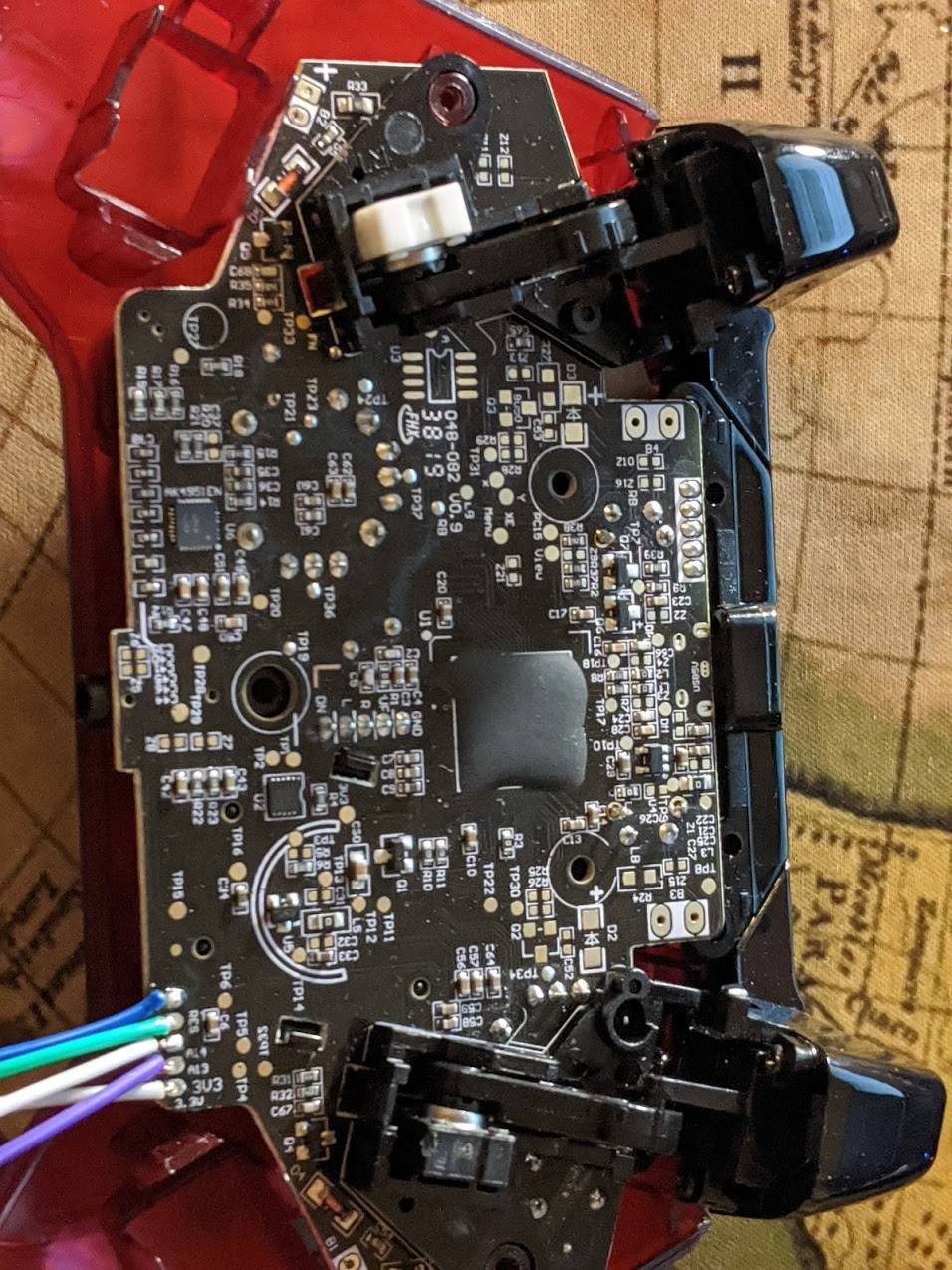
请注意,这里主芯片被环氧树脂覆盖了。幸运的是,有很多测试点都带有标签,但有标签的似乎是各种按键的测试点,所以没有什么令人兴奋的地方。
在板子的底部有一个标有AK4961的IC,实际上,这是一个音频编解码芯片。相关的数据手册可以从这里找到。这款芯片是一款低功耗24位立体声CODEC,带有麦克风、耳机和扬声器放大器。

然而,如果我们往右边看,则会发现一组带有丝印标签的测试点。
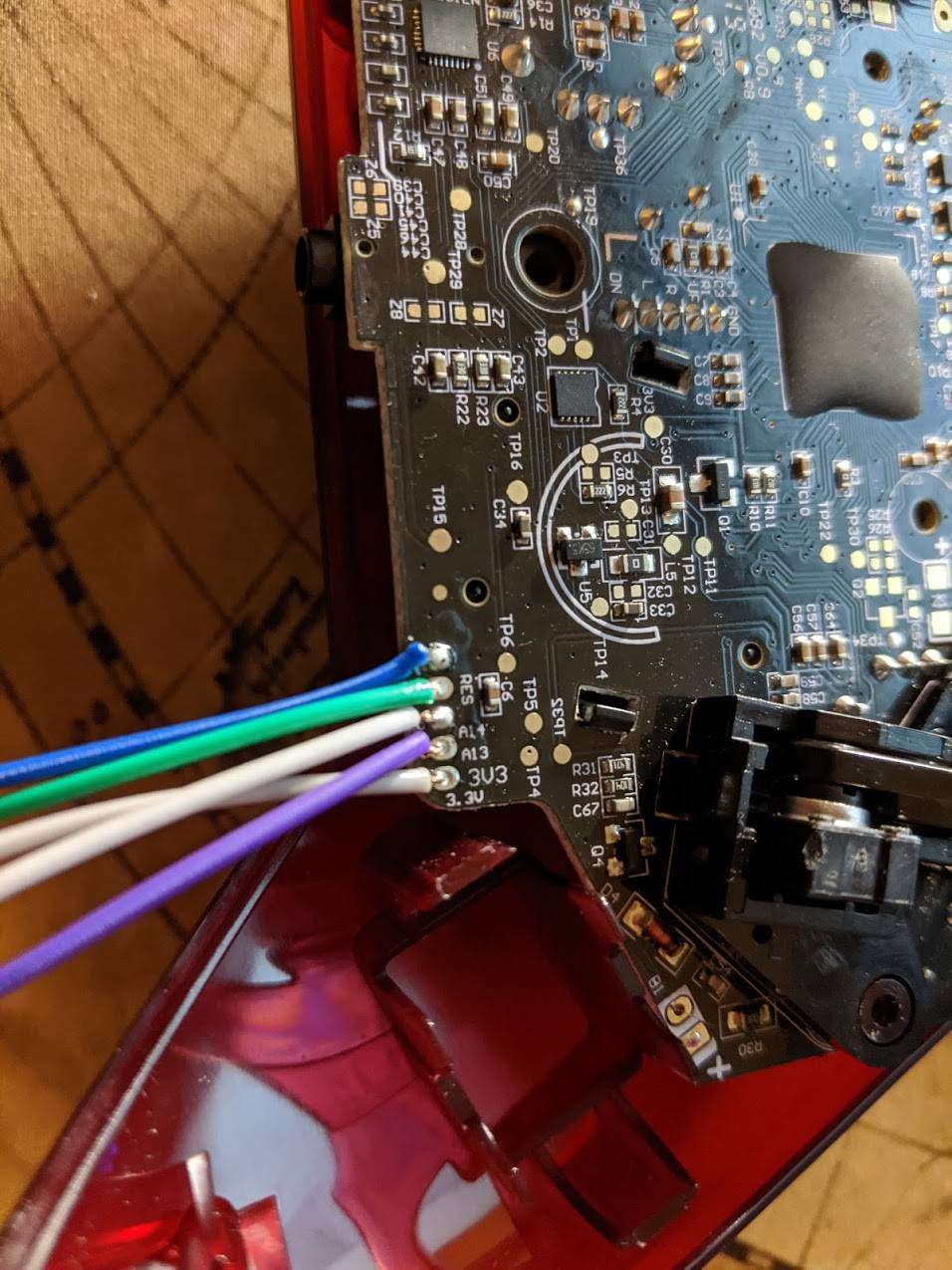
这里,我们看到标签3V3、A13、A14、RES。这些是值得关注的,尤其是看过我之前写的关于路由器拆机和发现UART的文章的读者,可能已经猜到接下来要如何操作了。首先,我们可以通过万用表测量一下各引脚的电压。

其中,在RES、A14或A13引脚上没有测到电压的变化,那么,这些到底是做什么用的呢?其中一个标签是RES(它可能代表system reset即系统重置),那么,它很有可能用于JTAG或SWD接头。
我们可以通过用10K电阻拉低RES引脚来测试它是否真的复位了目标(记住,我们在这里是反向的,所以,注意不要短路)。如果您不熟悉这些类型的接头或系统复位引脚的典型工作原理,那么就要注意了——它们通常为低电平有效,这意味着它们在高电平时处于空闲状态,所以,必须拉低才能激活。因此,如果我们监控DMESG-W的输出,并用一个10K电阻将此线路切换为低电平,我们会看到什么?
[ 2108.588884] usb 1-6.4: new full-speed USB device number 10 using xhci_hcd [ 2108.691108] usb 1-6.4: New USB device found, idVendor=0e6f, idProduct=02a2, bcdDevice= 1.0f [ 2108.691113] usb 1-6.4: New USB device strings: Mfr=1, Product=2, SerialNumber=3 [ 2108.691116] usb 1-6.4: Product: PDP Wired Controller for Xbox One - Crimson Red [ 2108.691119] usb 1-6.4: Manufacturer: Performance Designed Products [ 2108.691122] usb 1-6.4: SerialNumber: 0000AE38D7650465 [ 2108.698675] input: Generic X-Box pad as /devices/pci0000:00/0000:00:14.0/usb1/1-6/1-6.4/1-6.4:1.0/input/input25 [ 2131.403862] usb 1-6.4: USB disconnect, device number 10 [ 2133.420350] usb 1-6.4: new full-speed USB device number 11 using xhci_hcd [ 2133.522469] usb 1-6.4: New USB device found, idVendor=0e6f, idProduct=02a2, bcdDevice= 1.0f [ 2133.522474] usb 1-6.4: New USB device strings: Mfr=1, Product=2, SerialNumber=3 [ 2133.522478] usb 1-6.4: Product: PDP Wired Controller for Xbox One - Crimson Red [ 2133.522480] usb 1-6.4: Manufacturer: Performance Designed Products [ 2133.522483] usb 1-6.4: SerialNumber: 0000AE38D7650465 [ 2133.530103] input: Generic X-Box pad as /devices/pci0000:00/0000:00:14.0/usb1/1-6/1-6.4/1-6.4:1.0/input/input26
太好了,这样做会使控制器复位,即弄清楚了1个引脚的作用,还剩下2个引脚需要处理。
当看到这样的调试接头时,通常的假设是它用于JTAG或其他形式的硬件级调试。但是,JTAG规范要求至少有4个引脚,即TDO、TDI、TMS和TCK。但是,我们的目标上只有两个引脚,因此,它很可能是一个单线调试(SWD)端口。
关于SWD
SWD是用于ARM Cortex目标设备的通用调试接口。顾名思义,SWD仅需要一条数据线和一条时钟线,但是我们如何确定到底是哪一条呢?在此之前,我们应该多了解一些SWD的工作原理,以及可以使用哪些工具与之交互。
首先,SWD与称为“调试访问端口”(DAP)的接口连接。DAP用于访问各种“访问端口”(AP),这些端口提供的功能包括典型的硬件调试,旧式JTAG内核以及其他高性能内存总线。下图给出了DAP和AP的结构的直观表示。
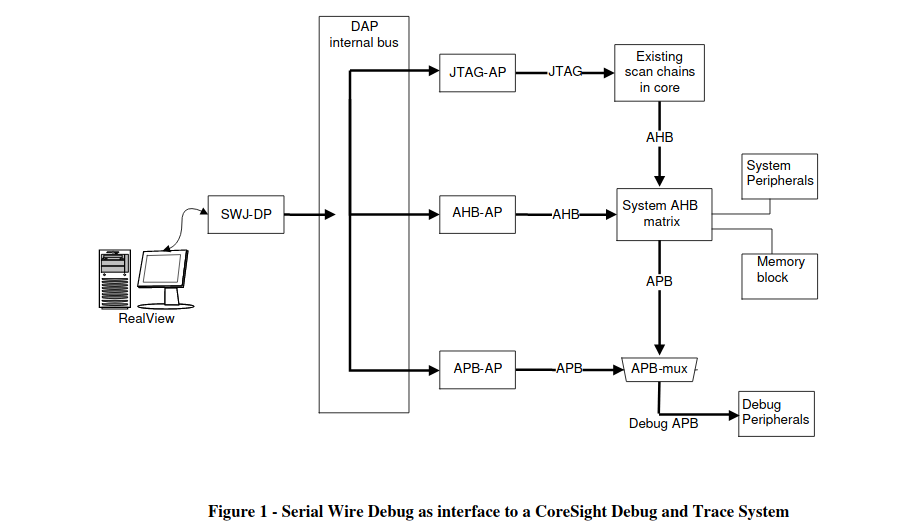
这些AP均由64个32位寄存器组成,其中一个寄存器用于标识AP的类型。AP的功能和特性决定了访问和利用这些寄存器的方式,详情可以参阅这篇文档。另外,ARM接口规范默认定义了两个AP,分别是JTAG-AP和MEM-AP。其中,MEM-AP还提供了发现与其连接的组件的相关机制。
SWD协议
如前所述,SWD是JTAG的伪替代品。使用SWD时,引脚数从4个减少到2个,并且提供了许多与JTAG相同的功能。但是,SWD的一个缺点是无法将设备以菊花链方式链接在一起,这正是JTAG所允许的。SWD中使用的两个引脚如下所示:
引脚 用途
SWCLK 提供给CPU的时钟信号,确定何时进行数据采样并通过SWDIO发送
SWDIO 双向数据引脚,用于与目标CPU之间的数据传输
SWD 利用基于数据包的协议读写DAP/AP中的寄存器,它们包括以下阶段:
· 从主机向目标发送数据包请求
· 总线转换
· 目标为主机返回确认响应
· 数据传输阶段
数据包的结构如下所示:

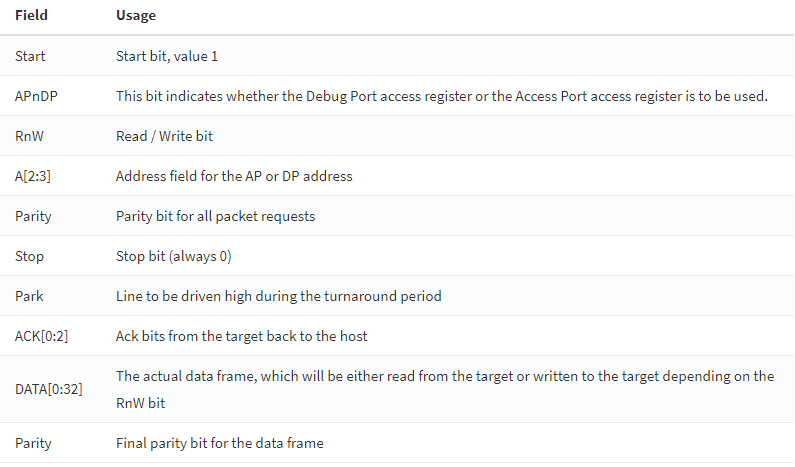
在park位(从主机到目标机)之后,有一个转换期,基本上意味着目标机现在将在同一条线上做出响应。
从一个较高的层次来看,SWD端口使用这些数据包与DAP进行交互,而DAP又允许访问MEM-AP,MEM-AP提供访问调试以及内存读/写功能。在本篇文章中,我们将使用一个名为OpenOCD的工具来执行这些事务。接下来我们将为读者介绍如何构建和使用OpenOCD。
OpenOCD
安装依赖库:
sudo apt-get install build-essential libusb-1.0-0-dev automake libtool gdb-multiarch
克隆存储库,并完成相应的配置和构建工作!
wrongbaud@115201:~/blog$ git clone https://git.code.sf.net/p/openocd/code openocd-code cd openocd-code ./bootstrap ./configure make -j$(nproc)
在构建好了OpenOCD之后,我们可以尝试在SWD上调试这个控制器。为此,我们至少需要告诉OpenOCD两件事:
· 我们使用什么进行调试(我们要使用哪个调试适配器)
· 我们调试的目标是什么
为了进行调试,我们将使用FT2232H,我们曾在前一篇文章中通过它来转储SPI闪存。有了这个接口,我们就可以让OpenOCD通过SWD查询有关目标的信息了,这一点非常重要,因为在逆向工程的这个阶段,我们甚至还不知道目标CPU到底是什么!
下表用于确定FT2232H上需要连接到SWD目标的引脚:
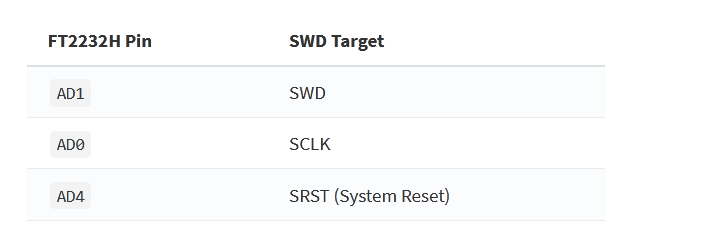
最后,为了将FT2232H用作SWD适配器,必须在FT2232H上的AD1/AD2之间放置一个470欧姆的电阻。
一旦我们将FT2232H上的引脚连接到目标,我们就可以使用以下脚本查询DAP控制器上的DPIDR寄存器了:
# We are using an FT2232H so specify this here interface ftdi # Provide the VID/PID of the FT2232H ftdi_vid_pid 0x0403 0x6010 # There are two channels, this is the default ftdi_channel 0 # To the best of my knowledge, this is used to properly set and confiture the state of the lines we are using ftdi_layout_init 0x0018 0x05fb # Enable SWD for the lines that we are using, and the port ftdi_layout_signal SWD_EN -data 0 # This is used to specify the sRST pin, in our case we're using ftdi_layout_signal nSRST -data 0x0010 # Here we are selecting SWD as opposed to another transport layer such as JTAG transport select swd # Set the speed of the adapter, this will vary based on what your hardware supports adapter_khz 100 # Create a new dap, (TAP for JTAG terms) with name chip and role CPU, -enable let's OpenOCD to know to add it to the scan swd newdap chip cpu -enable # Create the DAP instance, this must be explicitly created according to the OpenOCD docs dap create chip.dap -chain-position chip.cpu
我们可以使用openocd运行这个脚本,输出如下图所示(注意,第一次运行时并没有输出,交换SWD/SCLK线后,才会输出下面的结果)。从FT2232到控制器的连接方法见下表。

wrongbaud@wubuntu:~/blog/stm32-xbox$ sudo openocd -f openocd.cfg Open On-Chip Debugger 0.10.0+dev-01040-ge7e681ac (2020-01-27-18:55) Licensed under GNU GPL v2 For bug reports, read http://openocd.org/doc/doxygen/bugs.html Info : FTDI SWD mode enabled Info : Listening on port 6666 for tcl connections Info : Listening on port 4444 for telnet connections Info : clock speed 100 kHz Info : SWD DPIDR 0x2ba01477 Warn : gdb services need one or more targets defined
太棒了!我们发现了一个芯片ID即0x2BA01477,如果我们搜索这个ID,我们会发现许多Cortex M/STM32器件——这说明该处理器系列支持SWD。现在,我们可以与DAP进行通信,看看是否可以确定正在使用的处理器的具体型号——如果这是一个具有配置文件的处理器,我们就能够转储闪存内容,并从目标处理器获得其他辅助信息。有了这些额外的信息,我们就可以让OpenOCD创建一个目标,使用带有Cortex M定义的芯片,以更好地利用DAP来访问一些更通用的特性,同时,还可以帮我们进一步确定目标CPU的型号:
# Set up the GDB target for the CPU, cortex_m is the CPU type, target create chip.cpu cortex_m -dap chip.dap # init reads out all of the necessary information from the DAP, kicks off the debugging session, etc init # Read out the information from the DAP, including the ROM table dap info
当我们使用这个配置文件运行openocd时,会看到以下结果:
wrongbaud@wubuntu:~/blog/stm32-xbox$ sudo openocd -f openocd.cfg Open On-Chip Debugger 0.10.0+dev-01040-ge7e681ac (2020-01-27-18:55) Licensed under GNU GPL v2 For bug reports, read http://openocd.org/doc/doxygen/bugs.html Info : FTDI SWD mode enabled Info : clock speed 100 kHz Info : SWD DPIDR 0x2ba01477 Info : chip.cpu: hardware has 6 breakpoints, 4 watchpoints Info : chip.cpu: external reset detected Info : Listening on port 3333 for gdb connections AP ID register 0x24770011 Type is MEM-AP AHB3 MEM-AP BASE 0xe00ff003 Valid ROM table present Component base address 0xe00ff000 Peripheral ID 0x00000a0411 Designer is 0x0a0, STMicroelectronics Part is 0x411, Unrecognized Component class is 0x1, ROM table MEMTYPE system memory present on bus ROMTABLE[0x0] = 0xfff0f003 Component base address 0xe000e000 Peripheral ID 0x04000bb00c Designer is 0x4bb, ARM Ltd. Part is 0xc, Cortex-M4 SCS (System Control Space) Component class is 0xe, Generic IP component ROMTABLE[0x4] = 0xfff02003 Component base address 0xe0001000 Peripheral ID 0x04003bb002 Designer is 0x4bb, ARM Ltd. Part is 0x2, Cortex-M3 DWT (Data Watchpoint and Trace) Component class is 0xe, Generic IP component ROMTABLE[0x8] = 0xfff03003 Component base address 0xe0002000 Peripheral ID 0x04002bb003 Designer is 0x4bb, ARM Ltd. Part is 0x3, Cortex-M3 FPB (Flash Patch and Breakpoint) Component class is 0xe, Generic IP component ROMTABLE[0xc] = 0xfff01003 Component base address 0xe0000000 Peripheral ID 0x04003bb001 Designer is 0x4bb, ARM Ltd. Part is 0x1, Cortex-M3 ITM (Instrumentation Trace Module) Component class is 0xe, Generic IP component ROMTABLE[0x10] = 0xfff41003 Component base address 0xe0040000 Peripheral ID 0x04000bb9a1 Designer is 0x4bb, ARM Ltd. Part is 0x9a1, Cortex-M4 TPIU (Trace Port Interface Unit) Component class is 0x9, CoreSight component Type is 0x11, Trace Sink, Port ROMTABLE[0x14] = 0xfff42003 Component base address 0xe0041000 Peripheral ID 0x04000bb925 Designer is 0x4bb, ARM Ltd. Part is 0x925, Cortex-M4 ETM (Embedded Trace) Component class is 0x9, CoreSight component Type is 0x13, Trace Source, Processor ROMTABLE[0x18] = 0x0 End of ROM table Info : Listening on port 6666 for tcl connections Info : Listening on port 4444 for telnet connections
这样的话,我们不仅可以与DAP和MEM-AP进行交互,还可以通过GDB对目标进行调试。由于MEM-AP条目中的零件号0x411,我们还可以确定目标CPU属于STM32F2X系列:
MEM-AP BASE 0xe00ff003 Valid ROM table present Component base address 0xe00ff000 Peripheral ID 0x00000a0411 Designer is 0x0a0, STMicroelectronics Part is 0x411, Unrecognized Component class is 0x1, ROM table
不过,假如我们没有访问DAP的权限的话,能否通过内存读写来找出我们的目标是什么呢?为了弄清这一点,需要借助于STM32 CPU中常见的一些内存区域,其中存储了ID和闪存信息。有了这些信息,我们可以修改OpenOCD脚本来读取这些区域并查找相关的ID信息!下表包含ID信息的相关偏移量:
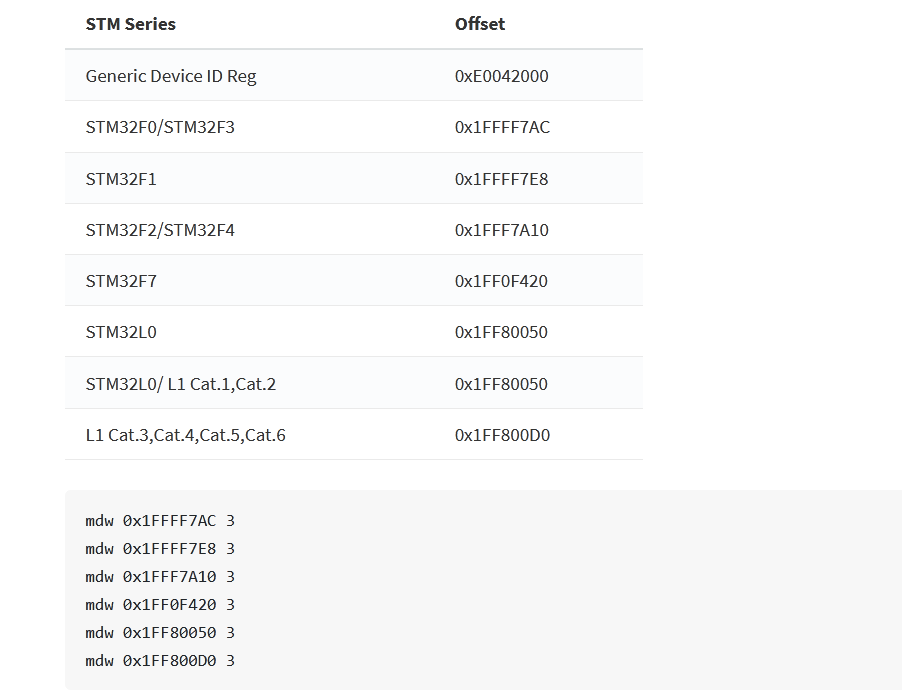
当我们运行升级后的OpenOCd脚本和以上命令时,我们会看到以下结果:
> mdw 0x1FFFF7AC 3 0x1ffff7ac: ffffffff ffffffff ffffffff > mdw 0x1FFFF7E8 3 0x1ffff7e8: ffffffff ffffffff ffffffff > mdw 0x1FFF7A10 3 0x1fff7a10: 006c0028 31385114 30373639 > mdw 0x1FF0F420 3 SWD DPIDR 0x2ba01477 Failed to read memory at 0x1ff0f424 > mdw 0x1FF80050 3 SWD DPIDR 0x2ba01477 Failed to read memory at 0x1ff80054 > mdw 0x1FF800D0 3 SWD DPIDR 0x2ba01477 Failed to read memory at 0x1ff800d4 >
我们可以使用以下命令,借助该芯片数据手册中的闪存地址或上面链接的存储库,来获得闪存大小:
> mdh 0x1FFF7A22 0x1fff7a22: 0100
现在我们已经知道了具体的目标,接下来就可以从配置文件中删除目标的swd、dap和target行,并在命令行中调用-f /usr/local/share/openocd/scripts/target/stm32f2x.cfg来替换它们。这样就可以正确地找出目标CPU。此外,我们现在还知道,这个STM32F2系列芯片具有0x100个1kb的闪存页。
wrongbaud@wubuntu:~/blog/stm32-xbox$ sudo openocd -f openocd.cfg -f /usr/local/share/openocd/scripts/target/stm32f2x.cfg [sudo] password for wrongbaud: Open On-Chip Debugger 0.10.0+dev-01040-ge7e681ac (2020-01-27-18:55) Licensed under GNU GPL v2 For bug reports, read http://openocd.org/doc/doxygen/bugs.html Info : FTDI SWD mode enabled adapter speed: 100 kHz Info : Listening on port 6666 for tcl connections Info : Listening on port 4444 for telnet connections Info : clock speed 1000 kHz Info : SWD DPIDR 0x2ba01477 Info : stm32f2x.cpu: hardware has 6 breakpoints, 4 watchpoints Info : Listening on port 3333 for gdb connections
现在,我们就可以使用以下命令来转储内部闪存了:
> flash list
{name stm32f2x base 0 size 0 bus_width 0 chip_width 0} {name stm32f2x base 536836096 size 0 bus_width 0 chip_width 0}
> flash read_bank 0 bank0.bin
device id = 0x00016423
flash size = 256 kbytes
wrote 262144 bytes to file bank0.bin from flash bank 0 at offset 0x00000000 in 3.690861s (69.361 KiB/s)
> flash read_bank 1 bank1.bin
flash size = 512 bytes
wrote 512 bytes to file bank1.bin from flash bank 1 at offset 0x00000000 in 0.007852s (63.678 KiB/s)我们还可以使用下面的命令,利用gdb对控制器进行调试:
wrongbaud@wubuntu:~/blog/stm32-xbox$ gdb-multiarch GNU gdb (Ubuntu 8.1-0ubuntu3.2) 8.1.0.20180409-git Copyright (C) 2018 Free Software Foundation, Inc. License GPLv3+: GNU GPL version 3 or later This is free software: you are free to change and redistribute it. There is NO WARRANTY, to the extent permitted by law. Type "show copying" and "show warranty" for details. This GDB was configured as "x86_64-linux-gnu". Type "show configuration" for configuration details. For bug reporting instructions, please see: Find the GDB manual and other documentation resources online at: For help, type "help". Type "apropos word" to search for commands related to "word". (gdb) set architecture arm The target architecture is assumed to be arm (gdb) target remote localhost:3333 Remote debugging using localhost:3333 warning: No executable has been specified and target does not support determining executable automatically. Try using the "file" command. 0x0800307e in ?? () (gdb) x/10x 0x1FFF7A10 0x1fff7a10: 0x006c0028 0x31385114 0x30373639 0xc000fcc0 0x1fff7a20: 0x0100c000 0x67ff47d2 0x05dcf000 0x04a803b3 0x1fff7a30: 0x451744b1 0xffffffff (gdb)
因此,现在我们不仅可以转储闪存,还能以单步执行方式调试固件,但是……我们能够刷新MCU吗?
如果我们可以在固件映像中找到USB描述符字符串并进行相应的修改,则可以将其用作一种可见的方法来确定是否可以修补固件。现在,让我们使用GHIDRA加载固件,看看是否可以找到它们,为此,可以将固件映像加载到地址0x8000000处。需要注意的是,这里的固件加载地址是通过数据手册查到的,但是,如果没有数据手册的话,则可以通过OpenOCD发出reset halt命令,并单步执行第一条指令来确定该地址。幸运的是,这个固件映像其实很小,因此Ghidra可以快速对其进行处理。在dmesg输出中看到的字符串如下图所示:
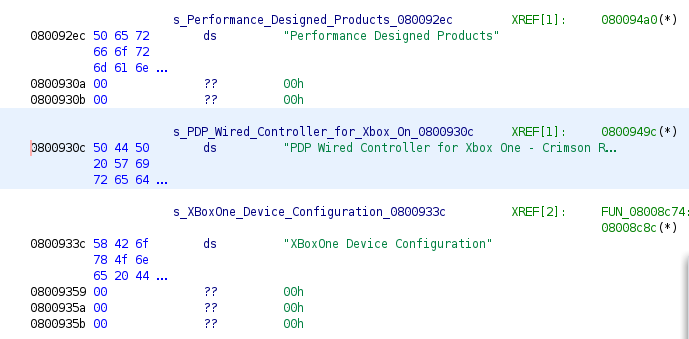
让我们用产品字符串做一个简单的补丁,将其改为“Testing Firmware Patches”。我们可以在OpenOCD的telnet控制台中使用以下命令来覆盖闪存:
wrongbaud@wubuntu:~/blog/stm32-xbox$ telnet localhost 4444 Trying 127.0.0.1... Connected to localhost. Escape character is '^]'. Open On-Chip Debugger > flash read 0 bank0-orig.bin > flash read_bank 1 bank1-orig.bin flash size = 512 bytes wrote 512 bytes to file bank1-orig.bin from flash bank 1 at offset 0x00000000 in 0.007867s (63.557 KiB/s) > stm32f2x unlock 0 Target not halted stm32f2x failed to unlock device > halt target halted due to debug-request, current mode: Handler External Interrupt(67) xPSR: 0x61000053 pc: 0x0800839c msp: 0x2000ff48 > stm32f2x unlock 0 stm32f2x unlocked. INFO: a reset or power cycle is required for the new settings to take effect. > reset halt target halted due to debug-request, current mode: Thread xPSR: 0x01000000 pc: 0x080002a4 msp: 0x20010000 > stm32f2x mass_erase 0 stm32x mass erase complete > flash write_bank 0 bank0-patch.bin wrote 262144 bytes from file bank0-patch.bin to flash bank 0 at offset 0x00000000 in 3.744948s (68.359 KiB/s) > reset >
这里有一些注意事项要说一下:
1. 在尝试刷新之前,请务必备份所有闪存映像。
2. 见上一条。
3. STM32闪存控制器有一个锁定位,可以防止意外的写入操作,我们可以在STM32的“Option bytes”中对其进行设置。
· 对我们来说幸运的是,我们能够解锁闪存,有时候根本无法解锁!
4. 对于STM32上的内部闪存,我们需要先执行擦除操作,然后再对其进行写入操作。
· 我要在这里补充一点,如果目标非常昂贵或特别重要,绝对不要这样做,除非您百分百确定可以将其恢复为原始状态。
5. 写入修改后的固件映像,然后重新启动CPU,以下内容会显示在dmesg中。
[54691.886194] usb 1-6.4: new full-speed USB device number 14 using xhci_hcd [54691.992411] usb 1-6.4: New USB device found, idVendor=0e6f, idProduct=02a2, bcdDevice= 1.0f [54691.992417] usb 1-6.4: New USB device strings: Mfr=1, Product=2, SerialNumber=3 [54691.992420] usb 1-6.4: Product: Testing Firmware Patches [54691.992423] usb 1-6.4: Manufacturer: Performance Designed Products [54691.992426] usb 1-6.4: SerialNumber: 0000AE38D7650465 [54691.998102] input: Generic X-Box pad as /devices/pci0000:00/0000:00:14.0/usb1/1-6/1-6.4/1-6.4:1.0/input/input28
太好了!这说明我们已经将固件完整提取出来,并加载到了ghidra中,接下来,我们就可以根据需要对其进行相应的修改了。
小结
在对嵌入式系统进行安全评估时,您通常希望枚举并探索与目标交互的所有可能的接口和方法。无论您的最终目标是寻找漏洞、修改设备的正常操作,还是仅仅为了解其工作原理,硬件调试都是非常有用的。通过硬件调试,我们不仅能够从这个目标中提取固件,设置一个实时调试器,并且还可以修改固件。通过本练习,我们还了解了单线调试的工作方式,以及如何用硬件调试工具识别、枚举和调试未知CPU。实际上,OpenOCD还可以与基于FT2232H的接口一起使用,以提取固件映像并将新固件重新刷写到目标上。谢谢您的阅读,希望本文对您的学习有所帮助!
本文翻译自:https://wrongbaud.github.io/posts/stm-xbox-jtag/如若转载,请注明原文地址:
如有侵权请联系:admin#unsafe.sh